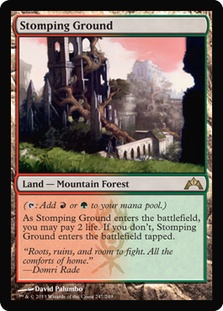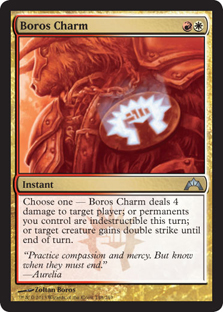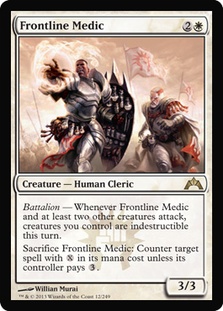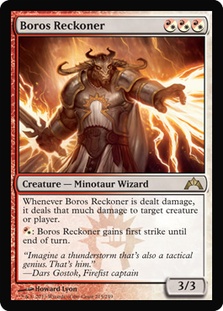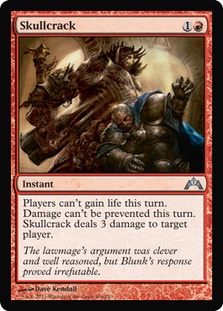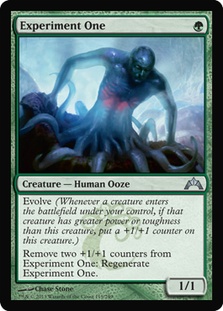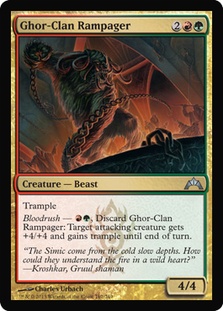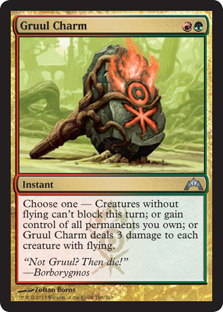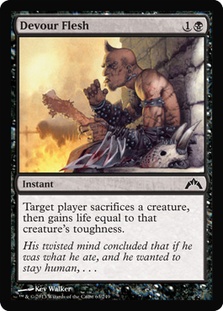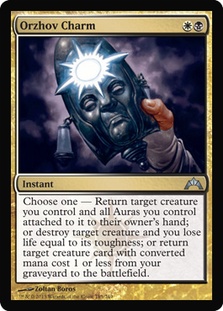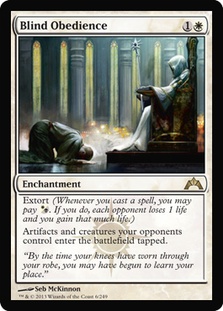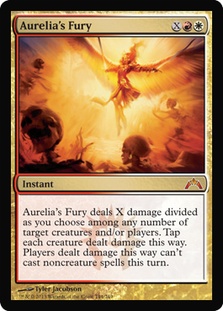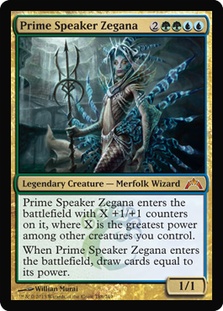So this is how it starts?
No, it started the moment the first Gatecrash card was previewed. It’s been going on all year. This is merely week 1 of the cards actually being tournament legal.
SCG Standard Open: Atlanta was the first major tournament with Gatecrash and one of two tournaments (the other being SCG Standard Open: Edison next week) that will pave the way for Pro Tour Gatecrash in Montreal in just two weeks’ time. It will also be interesting to see how big of an impact tournaments like the Classic Series in Memphis have.
The field in Atlanta was quite diverse, which was manifested in eight different archetypes making Top 8. Once we include the Top 16 and Top 32, we start to see a format taking shape that is a diverse mixture of aggro, control, midrange, tempo, and even a few combo decks. All five colors are well represented, with blue coming in a little behind the others.
The first Gatecrash Standard Open concluded with an all-Humans finals, with Joseph Herrera defeating Brian Braun-Duin with Naya Humans over Human Reanimator. I’d like to take a look at some of the decks of note, discussing the new technology utilized, but first let’s take a look at the metagame as a whole.
As always, this metagame breakdown is a winner’s circle metagame weighted by finish. This gives an idea of what the metagame looks like that you actually have to beat in order to win the tournament. The metagame usually looks a little different round 1, but we generally try to rely on player strength in the early rounds and metagame for the winner’s circle (since we don’t just want a winning record, we want to win the tournament).
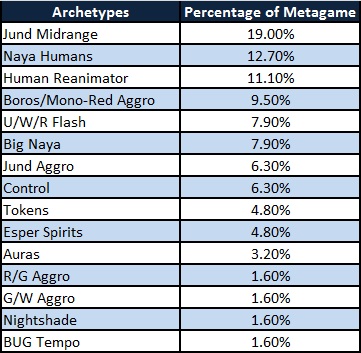
As you can see, this was an extremely diverse field. When was the last time we had fifteen archetypes in the Top 32? And that is even lumping Esper Control and Bant Control together, Dark Naya into Big Naya, and Boros Aggro with Mono-Red Aggro. This is not just a symptom of the format being new. For reference, the Top 32 of the first SCG Open after Return to Ravnica featured just nine archetypes, and that was a brand-new format immediately after a rotation.
Let’s start with the winner:
Creatures (31)
- 4 Champion of the Parish
- 4 Avacyn's Pilgrim
- 4 Mayor of Avabruck
- 3 Thalia, Guardian of Thraben
- 3 Huntmaster of the Fells
- 3 Restoration Angel
- 4 Silverblade Paladin
- 3 Nearheath Pilgrim
- 3 Frontline Medic
Lands (23)
Spells (6)

Tournaments held the day the set literally becomes legal are always tricky to evaluate. What choices are card availability, what choices are a result of not having tried new cards, and what choices are deliberate? Seeing Stomping Grounds is no surprise since they have been available. Boros Charms in the sideboard make it clear their absence from the maindeck is intentional. Three of a rare (Frontline Medic) suggest card availability was not an issue here.
Frontline Medic is a very powerful option for getting major edge over creature-based strategies. That it also fights Sphinx’s Revelation, Bonfire of the Damned, and more is just a bonus.
Here we see a deck built to maximize Champion of the Parish and Mayor of Avabruck. I wonder about the absence of Boros Elite. It seems like a Human deck would be a perfect place for him, as it has plenty of dudes to trigger him and actually wants to beatdown, and he’s even a Human. Of course, it’s possible he doesn’t play into the Huntmaster of the Fells / Restoration Angel game we are playing here.
Kessig Wolf Run over Gavony Township is interesting, suggesting the sorts of games Joseph envisions developing. I wonder about the use of so many Clifftop Retreats and only one Sacred Foundry. It seems like you’d want more than ten ways to play Champion of the Parish on turn 1.
I really like the Garruks in the sideboard. Izzet Staticaster is just an absolute nightmare for this deck, and Garruk is one of the best answers in the format. Its power level is high, but it is also a threat that hits from a different angle that you can afford to bring in against a control deck you suspect may have Staticasters but may not.
Creatures (17)
- 4 Fiend Hunter
- 4 Huntmaster of the Fells
- 4 Angel of Glory's Rise
- 1 Cathedral Sanctifier
- 4 Cartel Aristocrat
Lands (23)
Spells (20)

This evolution of Human Reanimator revolves around dredging until you have at least one of each of its principle four creatures and an Unburial Rites. Then you Unburial Rites the Angel, which returns the Humans (not to mention exiling Zombies). Fiend Hunter lets you exile your Angel. Cartel Aristocrat lets you sacrifice your Fiend Hunter to get back your Angel. These three alone are enough to loop, so all you need is something to loop. Huntmaster of the Fells gives you as many Wolves and as much life as you want, not to mention just being a fine card in its own right. Cathedral Sanctifier provides a back-up fifth target to loop.
Appetite for Brains is particularly important in the sideboard because it gives you a much-needed tool for taking Slaughter Games out of the opponent’s hands. Without your Angels, it is a lot tougher to present a big enough game to beat most people.
Creatures (26)
- 4 Stromkirk Noble
- 4 Hellrider
- 2 Stonewright
- 2 Lightning Mauler
- 2 Thundermaw Hellkite
- 4 Ash Zealot
- 4 Rakdos Cackler
- 4 Boros Reckoner
Lands (23)
Spells (11)
Sideboard

Schneider’s R/W Aggro is definitely from the Boros Deck Wins school of Boros, with just 2+2 Boros Charms on the splash. Perhaps more exciting than even Boros Charm, Boros Reckoner is provides a top tier three-drop that gives the strategy a much-needed trump to Thragtusk. Boros Reckoner makes Lightning Mauler look even more appealing, setting up some pretty brutal starts.
Skullcrack in the sideboard is no surprise, and I suspect that is where it belongs for now. Mizzium Mortars in the sideboard looks like a great call for this field. It’s not even totally clear that it isn’t supposed to be maindeck at the moment. What’s intriguing is the use of the full four Volcanic Strength. The printing Stomping Ground and Sacred Foundry means a lot more opponents are going to have Mountains. With as little removal as most people are playing, it sure is nice to puts some pants on someone and get in there unblockable every turn.
Creatures (28)
- 4 Strangleroot Geist
- 4 Hellrider
- 2 Thundermaw Hellkite
- 3 Flinthoof Boar
- 4 Dreg Mangler
- 3 Deathrite Shaman
- 4 Experiment One
- 4 Ghor-Clan Rampager
Lands (24)
Spells (8)

Jund Aggro? Oh, so you mean Gravecrawler, Geralf’s Messenger, Lotleth Troll, and Falkenrath Aristocrat?
Or, you know, none of them!
This is a new breed of Jund Aggro made possible by Experiment One. It more closely resembles a Zoo deck or, perhaps more accurately, a R/G Aggro deck splashing black for Dreg Mangler, Deathrite Shaman, and removal.
Four Ghor-Clan Rampagers is instant industry standard of course. Flinthoof Boar is also sure to gain a lot of popularity with the printing of Stomping Ground. Strangleroot Geist, Flinthoof Boar, Dreg Mangler, Hellrider, and Thundermaw Hellkite is a freaking metric ton of haste. Blind Obedience would be absolutely incredible against this deck.
Notice the use of all three Charms in the sideboard, including the much-maligned Gruul Charm. That didn’t take long, did it?
While Lindsey’s new style of Jund was the color combination’s highest finisher, it was true midrange Jund that was the biggest overall finisher at the event, being the most represented deck in the Top 32.
Creatures (14)
Planeswalkers (4)
Lands (25)
Spells (17)

The main strategy here is to use the relatively high quantity of removal to keep the major enemy threats down. Then superstars like Huntmaster of the Fells, Thragtusk, and most importantly Olivia Voldaren can actually take over the game. This strategy is quite effective against aggro decks but has trouble with people going over the top (such as Reanimator) or sidestepping it (such as Hexproof Auras).
Glaring Spotlight is an attempt to shore up the Aura weakness, but most of the other Jund players adopted some amount of Devour Flesh to complement their Lilianas and occasional red sweepers. For instance:
Creatures (15)
Planeswalkers (4)
Lands (25)
Spells (16)

Not only does Devour Flesh attempt to regain a little percentage against Auras, but Grafdigger’s Cage and Ground Seal along with Slaughter Games aim to combat graveyard strategies (although Mitchell doesn’t have the Deathrite Shamans that many others had).
Creatures (13)
Planeswalkers (1)
Lands (25)
Spells (21)

The latest incarnation of U/W/R Tempo has a number of deckbuilding choices of note. To begin with, Geist of Saint Traft is relegated to the sideboard. This is presumably a response to how aggressive the format is.
While most previous U/W/R Tempo decks featured at least two Thundermaw Hellkite at the top, Lear eschews them in favor of a Drogskol Reaver and a Jace, Memory Adept. This is another indication that Lear sees himself as the control deck against the majority of opponents. The use of two Supreme Verdict main as well as eight spot removal spells and four Azorius Charms only furthers advances the case.
Izzet Staticaster in the sideboard looks awesome right now. More Verdicts is to be expected, though I do wonder about the total lack of Terminus. The ability to go up to three Jace, Memory Adepts is particularly dangerous for anyone trying to win a drawn-out control battle.
Lear’s wasn’t the only blue midrange deck to Top 8. Hitting from a little of a different direction, Eddie Walker revived the Esper Spirits archetype, making great use of Watery Grave and Godless Shrine.
Creatures (18)
Lands (24)
Spells (18)
Sideboard

While the shocklands were vital to this archetype’s return, Walker actually has quite a few other Gatecrash cards in starring roles. To start with, Obzedat is actually a Spirit, making him totally obnoxious with Drogskol Captain. If you can stay on the offensive, Obzedat is actually a very difficult threat. He dodges burn, Ultimate Price, Detention Sphere, and most sweepers.
Actually, one of the few spot removal spells that can actually compete with Obzedat is Orzhov Charm, which Walker makes heavy use of. While he doesn’t have any one-drops to return, Orzhov Charm really is mostly about the removal spell element, though he will occasionally use it to return his creatures to hand (in a somewhat Unsummon like role).
Blind Obedience is particularly effective here. While it is always good against haste, adding it to an aggressive strategy lets you capitalize on how hard it will be for opponents to block you. The ability to repeatedly drain opponents is always great, but that it costs two is deceptively important to Spirits, a rare archetype in that it’s short of two-drops.
Devour Flesh in the sideboard gets the nod over Tribute to Hunger partially to help address the gap at two that Spirits suffers. Augur of Bolas is also to help the lack of two-drops. Why are we not more excited about Augur as a two-drop? Note that there are only fifteen hits for him maindeck, and after board we can go up to eighteen. Even when we board up to eighteen, we are only looking at a 66% chance of hitting. That isn’t terrible, but we probably only want it in matchups where a 1/3 for two is close enough to a real card that we can afford to miss a lot.
Creatures (10)
Planeswalkers (5)
Lands (25)
Spells (20)

Syed’s take on tokens is not just a descendant of various token decks—it clearly has Naya and Jund influences, with a whole lot of “good stuff” going on. There isn’t a ton of Gatecrash aside from shocklands (always the easiest part of a set to figure out), but he does use a single copy of Aurelia’s Fury as an additional big-mana threat. He also makes use of Devour Flesh in the sideboard, as so many do. It is worth noting the use of Bonfire of the Damned, a powerful card that has fallen out of favor as of late. Generally, we only see it in Jund and Big Naya, and then only from time to time.
The Top 8 decks give us a pretty good idea of where to start attacking. For those interested in control, let’s touch on the two styles of control that showed up. First, the more popular of the two, Esper:
Creatures (2)
Planeswalkers (7)
Lands (25)
Spells (27)

As regular readers would probably predict, Blind Obedience appears prominently. Mainly, we want the life gain and anti-haste abilities; however, the damage can really add up when combined with Lingering Souls.
Sideboarding a couple of fatties is nothing new, but Obzedat specifically has a different texture than something like Drogskol Reaver. Normally, we want the sideboard creature to be good at defending and helping us take over games. Obzedat is much more of an attacker, and here it actually seems like a new anti-control card. I am not totally sure about its place here, but the raw power level of Obzedat is quite high.
Creatures (13)
Planeswalkers (3)
Lands (26)
Spells (18)

Finally, we have Bant Control. While Bant did gain a lot of new dual lands (Watery Grave and Godless Shrine in addition to the obviously amazing Breeding Pool), its mana base wasn’t really the area it needed help. Where are the new answers to difficult threats like Falkenrath Aristocrat and Thundermaw Hellkite? My guess is that Blind Obedience is supposed to be that answer. The other possibility, of course, is to more heavily adopt a fourth color to get actual spot removal.
Prime Speaker Zegana is a huge threat, though it does have to compete with Angel of Serenity and Sphinx’s Revelation for big-mana bombs. The ability to abuse it with Restoration Angel, however, is one of the most powerful interactions in Standard.
Ok, I’m out for this week. I gotta go board that plane to NYC. Look, I love a humble brag as much as the next guy (assuming the next guy is not Tom Martell), but my mention of my teammates last week was more to make clear who I was testing with for this event and because I’m super excited. Playing games and talking about Magic with those guys really is as much fun as you’d imagine, perhaps even more so, as they are just a bunch of really fun dudes. Preparing for Pro Tours is basically my favorite time of year, and this format is looking like a deep and challenging puzzle to explore.
Now that we have day 1 of week 1 in the books, where is the format going next? Any predictions for this weekend’s SCG Standard Open? Post your predictions for the Top 8 decks here, and next week we’ll see who was the most accurate. If your prediction includes a Deck To Build, I will make a deck around the concept suggested by whoever most accurately predicted the Top 8. For our purposes here, actual finish isn’t important, just which eight archetypes (or if some appear multiple times, how many). Whoever is most right wins.
See you Monday!
Patrick Chapin
“The Innovator”

